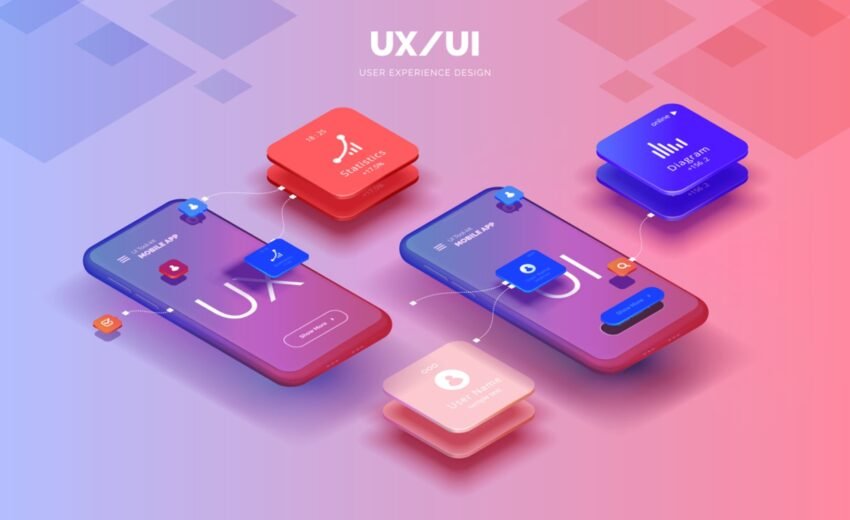
Hey there, fellow digital adventurers! Let’s kick things off with a topic that’s not just important but downright essential in today’s tech-driven world: UI/UX design. Yep, you heard it right. In 2024, UI/UX design isn’t just a buzzword – it’s the secret sauce behind every successful digital experience. From the moment you wake up and check your phone to the countless apps and websites you interact with throughout the day, UI/UX design is everywhere, quietly shaping our digital lives.
So, why exactly is UI/UX design such a big deal in 2024? Well, buckle up because I’m about to drop some truth bombs. In a world where attention spans are shorter than ever and competition is fierce, having a killer UI/UX design can be the difference between success and obscurity. Think about it – when was the last time you stuck around on a website or app that was clunky, confusing, or just plain ugly? Yeah, I thought so. In 2024, users expect nothing less than seamless, intuitive experiences, and UI/UX design is the key to delivering exactly that.
But here’s the thing – UI/UX design isn’t a one-and-done deal. Oh no, my friends, it’s a constantly evolving beast. Just when you think you’ve got it all figured out, along comes a new trend or technology to shake things up. That’s why staying updated with the latest trends and technologies is crucial for any UI/UX designer worth their salt. Whether it’s embracing the rise of voice interfaces, mastering the art of micro-interactions, or diving headfirst into the world of augmented reality, keeping your finger on the pulse of the industry is the only way to stay ahead of the game.
So there you have it, folks – a little taste of why UI/UX design is such a big deal in 2024. From shaping our digital experiences to driving innovation and pushing the boundaries of what’s possible, UI/UX design is the beating heart of the digital world. And hey, if you’re feeling inspired to dive into the world of design yourself, there’s never been a better time to start. So go forth, my friends, and create amazing things. The future is yours for the taking!
Table of Contents
Understanding UI/UX Design


Alright, let’s break it down – UI/UX design 101, coming right up! So, you’ve probably heard these terms tossed around a lot, but what exactly do they mean? Well, think of UI design as the pretty face of a digital product – it’s all about making things look good. We’re talking colors, fonts, buttons – you name it. On the flip side, UX design is like the brains behind the beauty. It’s all about making sure that the product not only looks good but also works well for the people using it. It’s like the difference between a beautifully designed car and one that’s a joy to drive. In 2024, nailing both UI and UX is like having the ultimate power duo for creating digital experiences that users will love.
Now, you might be wondering – why is UI/UX design so darn important anyway? Well, buckle up because I’m about to drop some truth bombs. In today’s hyper-competitive digital landscape, having a killer UI/UX design can mean the difference between sinking or swimming. Picture this – you’re browsing through an app or website, and it’s a total mess. Buttons are in weird places, the layout is all over the place, and nothing seems to work the way it should. Frustrating, right? That’s where UI/UX design swoops in to save the day. By creating intuitive, seamless experiences, UI/UX design ensures that users stick around, engage with your product, and keep coming back for more. And in 2024, when users’ expectations are higher than ever, having a top-notch UI/UX design is non-negotiable if you want to stay ahead of the curve.
So there you have it – UI/UX design demystified! It’s not just about making things look pretty or work well – it’s about creating experiences that users can’t get enough of. And in 2024, where digital products reign supreme, mastering the art of UI/UX design is like having the golden ticket to success. So whether you’re a seasoned pro or just dipping your toes into the design pool, remember – UI/UX design isn’t just a nice-to-have, it’s a must-have for anyone looking to make waves in the digital world.
Getting Started: The Basics of UI/UX Design


Alright, let’s kick things off with the fun stuff – getting started with UI/UX design! Now, before we dive into the nitty-gritty, let’s talk about the basics. When it comes to UI/UX design, it’s all about laying a solid foundation. We’re talking about understanding key principles like hierarchy, consistency, and usability. Hierarchy is like the superhero of design – it tells users what’s important and what’s not, guiding them through the experience. Consistency is all about keeping things looking and behaving the same across your product – because let’s face it, nobody likes surprises. And usability? Well, that’s the golden rule of UI/UX design – make it easy for people to use your product, and they’ll love you for it.
Now, let’s talk tools. When you’re just starting in the world of UI/UX design, having the right tools at your disposal can make all the difference. Luckily, there’s no shortage of options out there! Whether you’re team Adobe XD, Figma, Sketch, or something else entirely, there’s a tool out there to suit every taste and budget. And hey, don’t forget about resources! From online courses and tutorials to design communities and forums, there’s a wealth of knowledge just waiting to be tapped into. So go ahead, dive in, and start soaking up all that UI/UX goodness. Trust me, you’ll thank yourself later.
And there you have it – the basics of UI/UX design laid out in all their glory. Whether you’re a seasoned designer or just starting, understanding these foundational principles and having the right tools and resources at your disposal is key to success in the world of UI/UX design. So go forth, my friends, and start creating amazing experiences that users will love!
Trends and Innovations in UI/UX Design for 2024


Alright, let’s dive into the exciting world of UI/UX design trends for 2024! Get ready to be wowed because there’s some seriously cool stuff happening in the design sphere. From sleek new aesthetics to cutting-edge technologies, 2024 is shaping up to be a game-changer for UI/UX design.
First up, let’s talk about aesthetics. In 2024, minimalism is still king, but with a twist. We’re seeing a shift towards what I like to call “neo-minimalism” – think clean lines, bold typography, and vibrant colors, but with a modern, futuristic edge. It’s all about creating designs that are visually stunning while still being intuitive and user-friendly. And hey, don’t be afraid to experiment with unconventional layouts and design elements – after all, rules are meant to be broken!
Now, let’s talk about technology. In 2024, we’re seeing some seriously cool innovations that are revolutionizing the way we think about UI/UX design. Take augmented reality, for example. With the rise of AR technology, designers are now able to create immersive, interactive experiences that blur the lines between the digital and physical worlds. Whether it’s using AR to try on clothes virtually or visualize furniture in your living room, the possibilities are truly endless.
But it’s not just about flashy new tech – it’s also about creating experiences that are meaningful and impactful. That’s where case studies and examples come in. By studying real-world examples of innovative UI/UX design, we can learn valuable lessons and gain insights into what works (and what doesn’t). Take the redesign of the Airbnb app, for instance. By focusing on simplicity, clarity, and personalization, Airbnb was able to create a seamless booking experience that users love. Or how about the redesign of the Slack interface? By streamlining navigation and introducing new features like customizable themes and sidebar organization, Slack was able to enhance user productivity and satisfaction.
So there you have it – a glimpse into the exciting world of UI/UX design trends for 2024. Whether it’s experimenting with new aesthetics, embracing cutting-edge technologies, or studying real-world examples of innovative design, there’s never been a more exciting time to be a UI/UX designer. So go forth, my friends, and create experiences that inspire, delight, and wow users around the world!
Transitioning from Beginner to Intermediate


Alright, fellow designers, let’s talk about taking your UI/UX design skills to the next level. You’ve mastered the basics, and now you’re ready to level up – but where do you start? Don’t worry, I’ve got you covered. I’ve got some tried and true strategies that’ll help you advance your UI/UX design game like a pro.
First things first, let’s talk about strategy. One of the best ways to advance your UI/UX design skills is by having a game plan. Set specific goals for yourself – whether it’s mastering a new design tool, learning a new design concept, or completing a challenging project. Having clear objectives will keep you focused and motivated as you continue on your UI/UX design journey.
Next up, practical exercises and projects. Theory is great and all, but there’s no substitute for hands-on experience. Set aside time each week to work on practical exercises and projects that challenge you to apply what you’ve learned. Whether it’s redesigning a website, creating a new app prototype, or tackling a UX design challenge, the more you practice, the better you’ll get.
But don’t just stop there – seek feedback! One of the fastest ways to improve as a UI/UX designer is by getting feedback from others. Join design communities, participate in online forums, and don’t be afraid to ask for critiques from more experienced designers. Constructive feedback can help you identify areas for improvement and refine your design skills.
And last but not least, never stop learning. The world of UI/UX design is constantly evolving, so it’s important to stay curious and keep up with the latest trends and technologies. Take advantage of online courses, workshops, and conferences to expand your knowledge and stay ahead of the curve. The more you know, the more valuable you’ll become as a UI/UX designer.
So there you have it – some strategies for advancing your UI/UX design skills and practical exercises to help you hone your abilities. Remember, Rome wasn’t built in a day, and becoming a master UI/UX designer takes time and dedication. But with the right mindset and a commitment to continuous learning, there’s no limit to what you can achieve. So go forth, my friends, and design amazing things!
Mastering UI/UX Design: Advanced Techniques


Alright, folks, let’s talk about taking your UI/UX design skills to the next level – mastering those advanced techniques. You’ve conquered the basics, you’ve leveled up your skills, and now you’re ready to dive into the deep end of the UI/UX design pool. So, what exactly does that entail? Well, buckle up because we’re about to delve into some seriously advanced concepts and methodologies.
First up, let’s talk about advanced concepts. We’re talking about things like micro-interactions, design systems, and user research methodologies. Microinteractions are those tiny animations and feedback cues that make interactions feel super smooth and intuitive – think of them as the secret sauce that adds that extra layer of polish to your designs. Design systems, on the other hand, are like the backbone of your design process – they’re a set of rules, components, and guidelines that ensure consistency and coherence across your product. And user research? Well, that’s all about getting inside the heads of your users to understand what makes them tick – because let’s face it, designing for users you don’t understand is like trying to hit a bullseye with a blindfold on.
Now, let’s talk about specializations. The world of UI/UX design is vast and varied, and there are countless specializations and career paths to explore. Whether you’re passionate about interaction design, visual design, information architecture, or something else entirely, there’s a niche out there just waiting for you to dive in and make your mark. And hey, don’t be afraid to get creative – UI/UX design is a field that rewards innovation and experimentation, so don’t feel like you have to follow the beaten path. Blaze your trail, my friends, and who knows where it might lead?
So there you have it – mastering UI/UX design means delving into advanced concepts and methodologies, and exploring the myriad specializations and career paths within the field. It’s a journey of continuous learning and growth, but trust me when I say that the rewards are more than worth it. So go forth, my friends, and become the UI/UX design masters you were always meant to be!
FAQs (Frequently Asked Questions)


What exactly is UI/UX design, and why is it so important in the digital world?
UI/UX design refers to the process of designing user interfaces and experiences for digital products such as websites, mobile apps, and software. It’s crucial because it directly impacts how users interact with and perceive these products, ultimately influencing their satisfaction and usability.
How does UI design differ from UX design, and why are both necessary for creating successful products?
UI design focuses on the visual aspects of a product, such as layout, typography, and color schemes, while UX design deals with the overall user experience, including usability, accessibility, and user satisfaction. Both are necessary because a visually appealing UI is ineffective if the user experience is poor, and vice versa.
What are some key principles or best practices to follow when designing UI/UX?
Some key principles include simplicity, consistency, clarity, and user-centered design. It’s essential to prioritize the user’s needs and preferences throughout the design process.
What are some essential tools and software used in UI/UX design, and how do I choose the right ones for my projects?
Essential tools include Adobe XD, Figma, Sketch, and InVision for prototyping and design, as well as tools like UserTesting and Hotjar for user research and testing. Choose tools based on your specific project requirements, budget, and personal preference.
How can I get started learning UI/UX design, especially if I have no prior experience?
Start by learning the fundamental principles of UI/UX design through online courses, tutorials, and books. Practice by working on projects and experimenting with different design tools and techniques.
What are some common challenges faced by UI/UX designers, and how can I overcome them?
Common challenges include balancing aesthetics with functionality, addressing diverse user needs, and keeping up with evolving design trends and technologies. Overcome them by seeking feedback, staying curious, and continually learning and adapting.
How do I stay updated with the latest trends and advancements in UI/UX design?
Stay updated by following design blogs, subscribing to newsletters, attending conferences and webinars, and actively participating in design communities on social media platforms.
What role does user research play in UI/UX design, and how can I conduct effective user research?
User research helps designers understand user behaviors, preferences, and pain points, informing design decisions. Conduct effective user research through methods such as interviews, surveys, and usability testing.
What are some strategies for creating intuitive and user-friendly navigation in UI/UX design?
Strategies include organizing content logically, providing clear navigation labels and menus, minimizing clutter, and ensuring consistency across the interface.
Can you provide tips for creating visually appealing and engaging UI/UX designs?
Tips include using whitespace effectively, choosing a cohesive color palette, incorporating engaging visual elements like images and illustrations, and prioritizing readability and accessibility.
How important is accessibility in UI/UX design, and what are some best practices for ensuring accessibility?
Accessibility is crucial for ensuring that digital products are usable by people of all abilities. Best practices include using semantic HTML, providing alternative text for images, and testing with assistive technologies.
What career opportunities are available in the field of UI/UX design, and what skills are employers looking for?
Career opportunities include UI/UX designer, UX researcher, interaction designer, and more. Employers look for skills such as proficiency in design tools, strong communication and collaboration skills, and a solid understanding of UX principles and methodologies.
Conclusion


Alright, let’s wrap things up with a final word on the incredible journey of UI/UX design. We’ve covered a lot of ground, from understanding the basics to exploring advanced techniques and everything in between. As we reflect on the evolution of UI/UX design, one thing becomes abundantly clear – it’s come a long way, baby!
In 2024, UI/UX design isn’t just a nice-to-have – it’s an absolute game-changer. From shaping our digital experiences to driving innovation and pushing the boundaries of what’s possible, UI/UX design is the beating heart of the digital world. And as technology continues to advance and user expectations soar, the significance of UI/UX design only grows stronger. It’s not just about making things look pretty or work well – it’s about creating experiences that users can’t get enough of.
But here’s the thing – the journey of UI/UX design is far from over. It’s just getting started. Aspiring designers take note – there’s never been a better time to dive into the world of UI/UX design. With endless opportunities for learning, growth, and creativity, the sky’s the limit. So whether you’re just starting or a seasoned pro, remember – the only limit is your imagination. So go forth, my friends, and create amazing things. The future of UI/UX design is yours for the taking!
30 Days Plan to Learn UI/UX Design
Week 1: Getting Started
Day 1-2: Introduction to UI/UX Design
Research and read articles or watch videos that introduce you to the fundamentals of UI/UX design.
Familiarize yourself with basic terminology and concepts.
Day 3-5: Explore UI and UX Principles
Dive deeper into the principles of UI design (layout, typography, color, etc.) and UX design (usability, accessibility, etc.).
Study examples of good and bad design to understand what works and what doesn’t.
Day 6-7: Choose Your Tools
Research different design tools such as Adobe XD, Figma, Sketch, or InVision.
Choose one tool to focus on for the rest of the month and start familiarizing yourself with its features.
Week 2: Hands-on Practice
Day 8-10: Design Basics
Start experimenting with your chosen design tool by creating simple designs.
Practice creating wireframes, mockups, and prototypes for basic interfaces.
Day 11-14: Project 1: Redesign a Simple Interface
Choose a simple app or website interface to redesign.
Apply the principles you’ve learned to improve its UI/UX design.
Iterate on your designs based on feedback from friends, family, or online communities.
Week 3: Deep Dive into UX Design
Day 15-17: User Research
Learn about different methods of user research, such as interviews, surveys, and usability testing.
Conduct a simple user research project, such as interviewing friends or family members about their experiences with a digital product.
Day 18-20: Information Architecture
Study the principles of information architecture and how to organize content effectively.
Practice creating sitemaps and user flows for different scenarios.
Day 21: Mid-Point Check-In
Reflect on your progress so far and identify areas for improvement.
Set goals for the remainder of the month based on your strengths and weaknesses.
Week 4: Advanced Techniques
Day 22-24: Interaction Design
Explore advanced techniques in interaction design, such as micro-interactions and animations.
Experiment with adding subtle interactions to your designs to enhance the user experience.
Day 25-27: Specializations and Career Paths
Research different specializations within UI/UX design, such as visual design, interaction design, or UX research.
Explore potential career paths and job opportunities in the field.
Day 28-29: Project 2: Portfolio Piece
Choose a more complex interface to redesign or create from scratch.
Focus on showcasing your skills and creativity in your portfolio piece.
Day 30: Final Reflection and Next Steps
Reflect on your journey over the past 30 days and celebrate your achievements.
Identify areas for further improvement and set goals for continued learning and growth in UI/UX design.
Remember, learning UI/UX design is a journey, not a destination. Stay curious, keep practicing, and don’t be afraid to experiment and make mistakes. With dedication and persistence, you’ll be well on your way to mastering the art of UI/UX design!
🌐 Connect with us:
website: https://hubtech.pk/
Youtube: https://www.youtube.com/@hubtechpk
Facebook: https://web.facebook.com/hubtechpk/
Instagram: https://www.instagram.com/hubtechpk
Twitter: https://www.twitter.com/hubtechpk
Tiktok: https://www.tiktok.com/@hubtechpk







The Ultimate Handbook on User Interface Design Principles in 2024 - Hub Tech February 15, 2024
[…] Time Travel: The Evolution of UI/UX […]